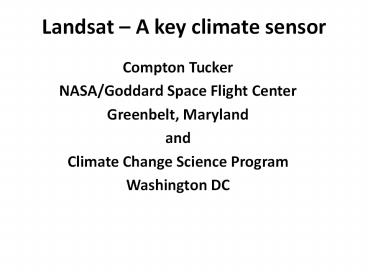Landsat%20 PowerPoint PPT Presentation
Title: Landsat%20
1
Landsat A key climate sensor
- Compton Tucker
- NASA/Goddard Space Flight Center
- Greenbelt, Maryland
- and
- Climate Change Science Program
- Washington DC
2
Houston, We Have a Problem
We are altering our planets climate
3
Atmospheric CO2 since 1740
385 ppm now
Different d CO2 slopes d
time reflect techno-economic conditions
4
What? Me worry?
5
What do we need to be rescued from?
6
Landsat A key climate sensor
- Absolutely crucial land climate sensors
- Landsat 1972 now
- AVHRR-MODIS-VIIRS continuum 1981 -- now
- Lidar for the 3rd Dimension (DESDnyI)
- Why?
- Land use, land cover change
- Carbon cycle land
- Cryosphere, etc.
7
Landsat A key climate sensor
- Why?
- 30 m spatial resolution close-to-perfect match to
surface variability (Townshend and Justice 1988) - Spectral bands are well situated
- Repeat cycle OK
- Excellent data system
8
Tropical Glaciers of Peru Bolivia
Landsat data from 1972 to 2008
Compton Tucker, Tim Killeen, and Dan Slayback
NASA/GSFC Code 610 Conservation International
90 of worlds tropical glaciers are in Peru
(70) and Bolivia (20) 5500-6500 m elevations,
summer growth/winter recession
9
Study Area and Landsat Scenes Used (WRS-2)
10
Cordillera Blanca Peru 2006
11
Cordillera Blanca22-Jul-2006 / TM5 / 543
12
Landsat-4/5 TM Data Used
13
(No Transcript)
14
Tropical Glaciers of Peru Bolivia1982-1986
2,854 km22006-2007 2,150 km2
90 of worlds tropical glaciers are in Peru
(70) and Bolivia (20) 5500-6500 m elevations,
summer growth/winter recession
15
How to enhance Landsat
- Landsat exploits the spatial spectral domains
- 30 m spatial resolution excellent
- Excellent spectral band selection
- Exploit the time domain (e.g. AVHRR, MODIS,
Seawifs, etc.) but at 30 m spatial resolution
with TM/ETM spectral bands - Wider field of view, 4-5 day repeat cycle
- Build multiple instruments (e.g. Landsat-5s TM)
Continuity!!
16
(No Transcript)
17
Tropical Air Temperature
18
Cloud cover variations 1978 to 2004
19
Cloud cover variations 1978 to 2004
PowerShow.com is a leading presentation sharing website. It has millions of presentations already uploaded and available with 1,000s more being uploaded by its users every day. Whatever your area of interest, here you’ll be able to find and view presentations you’ll love and possibly download. And, best of all, it is completely free and easy to use.
You might even have a presentation you’d like to share with others. If so, just upload it to PowerShow.com. We’ll convert it to an HTML5 slideshow that includes all the media types you’ve already added: audio, video, music, pictures, animations and transition effects. Then you can share it with your target audience as well as PowerShow.com’s millions of monthly visitors. And, again, it’s all free.
About the Developers
PowerShow.com is brought to you by CrystalGraphics, the award-winning developer and market-leading publisher of rich-media enhancement products for presentations. Our product offerings include millions of PowerPoint templates, diagrams, animated 3D characters and more.

